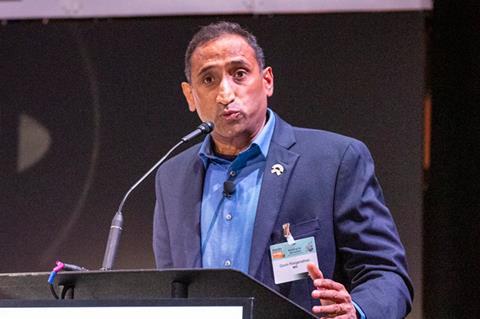As overall US vehicle sales slow down and EV sales remain stagnant, there are concerns that some OEMs are chasing new-generation technologies at the expense of their existing business – potentially setting up a ‘make or break’ scenario in the near future

Declining vehicle sales and investment in new vehicle technology driven by a stricter emissions regulations are combining with the impact of global trade wars to make things very difficult for the automotive industry in the near term. Analysts at last week’s Automotive Logistics Global Detroit conference said that the next five years could be ‘make or break’ for many in the industry, with some aggressive restructuring and retrenchment ahead.
Faced with a slowdown in US vehicle sales from next year, and with a possible recession on the way, carmakers and suppliers in that market may have to wait longer to see any return on the significant investments they are making in connected, autonomous and electric vehicle (EV) technology.
Brandon Mason, automotive director and mobility leader at PWC, said the automotive sector should expect significant capital pressure over the next few years. While it is currently at a peak, with sales expected to reach 16.9m units this year, carmakers are operating at high single-digit margins in terms of profit, which could be precarious if current expenditure on new vehicle technology continues. That is because sales are expected to retract over the next three to four years, down to 15.9m in 2021, and will not top out again until 2025.
“I think industry consolidation is inevitable. Five or ten years from now, the landscape is going to look significantly different than it does today” – Brandon Mason, PWC
“[The industry] is continuing to invest heavily in next-generation technologies but if the return on investment is further out, what does that look like for the bottom line?” asked Mason.
He said that some carmakers were looking too far ahead and focusing on next-generation technologies when the existing (and more substantial) business merited attention. While electric and hybrid vehicle sales remain stagnant in the US, at 1.5% of market share, petrol-fuelled pickup trucks and SUVs make up the majority of sales, though regulations on the horizon may change this.
Threat of consolidation
PWC Strategy& published a study earlier this year called ‘Facing up to the auto innovation dilemma’ which speculates that, if investment in new-generation technologies continues at its current high rate and there is a more significant downturn in car sales, there will be a dramatic shift in the automotive landscape at an OEM and tier supplier level.
Mason said that companies which have invested heavily in vehicle technology would need to bridge the gap of lower profitability before the market returns and the price of EVs begins to reach a parity with combustion engine cars.

“I would argue that many of the companies do not have that runway, over five to ten years, to continually spend that money before they start to see returns,” said Mason.
The report looked at factors including Ebit, capital return, and the introduction of EV, plug-in and hybrid vehicles. The preferred scenario, according to Mason, would be to offset some of the costs of the technological development through strategic partnerships, working with technology companies or with hedge fund providers.
Mason went on to say that there is going to be an acceleration in the number of alliances, mergers and acquisitions toward 2025. He also forecast an increase in restructuring and more aggressive cost reduction programmes.
“I think industry consolidation is inevitable,” said Mason. “Five or ten years from now, the landscape is going to look significantly different than it does today. The companies that are making big bets and don’t have the runway will go bankrupt or get bought up by other companies. The landscape is getting increasingly competitive and not everyone has the resources.”
This assessment was echoed by Daniel Harrison, automotive analyst at Ultima Media and author of a new report released by Ultima Media’s automotive business intelligence unit, ‘Automotive headwinds align into a perfect storm’. The report foresees significant risks for the industry and shows that there have been significant declines in various regions since 2017.
“Many [consumers] are waiting for the roadmap for electrification to be clearer before they make a choice; they don’t want to be an early adopter and choose the wrong vehicle” – Daniel Harrison, Ultima Media
Harrison said the weakening macroeconomic climate was exposing OEMs to considerable risk, just at a time when carmakers were coming under intense pressure to invest in EVs, and that the established business models of most carmakers would be challenged. The logistics sector has also felt the strain and seen some consolidation, such as DSV’s takeover of Panalpina. That said, logistics is a highly fragmented industry and there is plenty of room for further consolidation.
For carmakers, however, the ground is shifting. Customers are opting for used vehicles rather than new and are holding back on EV purchases until it becomes clear which way the market is heading.
“Many are waiting for the roadmap for electrification to be clearer before they make a choice; they don’t want to be an early adopter and choose the wrong vehicle,” said Harrison. [Also] vehicles are getting more expensive, which is deterring consumers, and used vehicles are becoming more attractive.”

A build-to-order future
Beyond 2025, however, the market in electric, connected and autonomous vehicles is set to flourish. In terms of EVs there are already positive signs, for example the VW Group’s pledge to invest €30 billion and develop 70 new electric models by 2023. At the Frankfurt Motor Show earlier this month, VW launched its ID.3 entry level EV which, according to Harrison, is “a game-changer in terms of affordability and performance”.
It is not just the major carmakers that are taking part in the electric future, of course. The relative simplicity of the EV powertrain makes it attractive to new entrants and they were also represented at this year’s conference.
Chinese EV start-up Nio began delivering its ES6 model to users in Beijing, Shanghai and Guangzhou in June, its second mass production model after the ES8, a five-seater, long range SUV.
Govin Ranganathan, head of logistics at Nio USA, explained that EV start-ups share some traditional manufacturing and logistics tenets such as supply chain and inventory visibility, with end-to-end tracking and collaborative logistics being common to all manufacturers working today.
“In traditional car making the pipeline is predictable and built up to optimise factory production. In the start-up environment we want a lot of flexibility, which does put a lot of challenges onto the logistics” – Govin Ranganathan, Nio USA
However, EV start-ups, being small and “cash strapped”, he said, are looking at build-to-order production, rather than the traditional build-to-stock model. That has consequences for the logistics side of the business.
“In traditional car making the pipeline is predictable and built up to optimise factory production,” said Ranganathan. “In the start-up environment we want a lot of flexibility, which does put a lot of challenges onto the logistics because we have to react quickly, and because of inventory. We want to work with partners that are able to react quickly.”
EVs on average have 30% fewer moving parts but are as complex as a traditional combustion engine vehicle when looked at from an assembly standpoint. The battery pack and other specialist components have certainly introduced new headaches for those in charge of inbound logistics.
Handling EV batteries
While battery cells are moved globally without much difficulty (for example, Tesla imports 50% of the cells it uses in Nevada from Panasonic in Japan), the movement of the battery itself is another matter. It is the biggest component of an EV and normally weighs about 600kg. It is also hazardous cargo and subject to handling regulations that vary from region to region, all of which impact on logistics. Therefore, most OEMs look to assemble the battery next to the vehicle plant.

“If you are shipping batteries you will ‘weigh out’ before you ‘cube out’,” said Ranganathan. “It makes sense to have battery assembly close to where car assembly is.”
Ranganathan said it was difficult to find logistics providers that had the certification and trained personnel to handle batteries, as they represent only 5% of the logistics market. However, he noted that the increasing demand for such services was an opportunity for the logistics sector.
That opportunity has been embraced by Hellmann Worldwide Logistics, for one. The company has been working with Tesla for the last five years, managing its global supply chain and providing real-time tracking. But Martin Wehner, global vice-president of automotive, also recognised the challenges involved in transporting the batteries.
“It requires a lot of effort and there is some customisation still needed, as well as the development of packaging to make it safe. You also have to talk in detail with governments and authorities to convince them. Then you can walk your way through, but you have to invest the time to do it.”
“What we have been encountering is that the carrier base has mixed knowledge and understanding of what the regulations are because they are changing so frequently” – Martin Wehner, Hellmann Logistics
A related area that is currently short on expertise is the handling of batteries collected for reuse and recycling, something noted by another EV start-up, US-based Rivian.
Rivian has yet to go into production but Kevin Takei, senior manager of logistics operations at the company, said it was looking for logistics providers that were well versed in the regulations governing the recovery of lithium batteries.
“We have our own in-house experts that have become DG [dangerous goods] certified and we understand how we need to receive these goods but also how we need to ship them out,” said Takei. “But what we have been encountering is that the carrier base has mixed knowledge and understanding of what the regulations are because they are changing so frequently. That is what we are looking for as an OEM, that our carriers can be partners.”
Connected logistics
Meanwhile, developments in connected vehicle technology, including more sophisticated telematics, are being exploited to improve efficiency in both inbound and outbound logistics. Sophisticated sensor technology throughout the car is combining with improved internet connections to provide instant data on a range of vehicle functions and location. There are thus opportunities for information gathering that can be fed into supply chain logistics.

Chris Styles, senior director of logistics at Nissan North America, said that collecting data from the connected car could help to generate more accurate logistics costing and simplify the product line-up, which can be especially diverse in the truck sector.
“As of today we can only cost out an average logistics cost for all the parts that go into a particular truck,” noted Styles. “You are working off a lot of averages, without getting into the true cost of every offering, but as we start getting more data back on what is being used and purchased, pretty soon we can get toward a VIN-level logistics cost.”
Styles said Nissan could then work out exactly what the logistics cost would be for every single part that is going into the truck and see what is actually being used. “We can drive that information back upstream to our product planning team and let them know what is happening in the market versus what they had planned for,” he said. “Hopefully what that does is narrow down the complexity of the vehicles as they are developing them.”
As regards outbound logistics, Marc Brazeau, head of logistics at FCA in the US, said that developments in connected vehicle technology were moving at breakneck speed and the question now was where to invest capital and how to support progress.
“As of today we can only cost out an average logistics cost for all the parts that go into a particular truck… but as we start getting more data back on what is being used and purchased, pretty soon we can get toward a VIN-level logistics cost” – Chris Styles, Nissan North America
“We need to ensure we are all investing in the right technologies as they become available and hit critical mass, reducing cost and complexity for everybody, and improving transparency,” he said.
Reducing complexity and improving transparency depends on the industry aligning on data protocols. While the industry has examples of where it has successfully aligned in the past, such as with electronic data interchange, carmakers select data according to their individual priorities and use different systems to do so, each of which the logistic provider then has to interpret.
Going forward, said Brazeau, the data being generated by the connected vehicle needs to look exactly the same to everyone involved in the supply chain. “Standards are key to enable the work that providers do to help streamline what we do,” he stated. “It lowers the barriers to innovation in the industry including for the new entrants.”
Connected Vehicle Committee
Establishing those standards is something the Automotive Industry Action Group (AIAG) has been working towards since April last year, when it set up its Connected Vehicle Committee. The committee brings together OEMs with the aim of establishing how and what kind of data will be collected from the connected vehicle, and how it will be shared between vehicle-makers and their logistics service providers (LSPs). The AIAG is due to publish its first guidelines based on the committee’s work in the next six to eight weeks.

Ben Shain, director of vehicle logistics at Nissan North America, said that the committee had looked at 19 different elements related to connected vehicle data use – only in phase one.
“The idea is that we have a shared network linking truck, rail and ports, and we want to leverage that within the 3PLs. But we don’t want them having to go through multiple formats and trying to interpret it; we want it to be optimised so we can take advantage and get speed to market,” stated Shain.
FCA’s Brazeau said the upcoming guidelines will include a series of use cases that should help logistics providers to understand OEM expectations and plans for connected vehicle data.
“The use cases you will see soon are going to be the things that will help [LSPs] over the next couple of years to interact with us in terms of what investments or what opportunities [exist],” said Brazeau.
Taking vehicle location coordinates as an example, he said one idea for the future was to align geofence perimeters and descriptors in the physical locations that 3PLs manage. He invited the LSPs gathered in Detroit this year to read the use cases and think about whether there should be a publication for geofence locations that anyone could plug into and understand.
“The idea [of the AIAG’s Connected Vehicle Committee] is that we have a shared network linking truck, rail and ports, and we want to leverage that within the 3PLs” – Ben Shain, Nissan North America
Brazeau also pointed to the development of control towers designed to automatically lock and unlock vehicles, part of a plan at FCA to dispense with key fobs because of the risk of loss and theft. “If a key fob gets lost there are productivity risks, certainly on the rail network, where cars can get stuck on the rail car and you can’t get them off,” he explained.
“I think once you see the publication it is going to create an awful lot of dialogue between the OEMs and the industry,” he said. “Those are the areas that I think are exciting and there are smarter people than us out there that are going to figure out how this data can be leveraged, and what innovative apps and technology can be derived.”
Nissan’s Shain advised the logistics sector to examine the use cases and identify the likely impacts if the specified issues can be eliminated. “As a provider, as soon as you see that it is going to be advantageous to start formulating for what we call in Nissan ‘lost cost’, you have a business case,” he said.

Doug Smith, mobility product owner for connected vehicle platform and products at Ford, added that once the standards were out, the ideas would start flowing in. He pointed to the benefits of using vehicle connectivity in the real-time identification of specific vehicles to pick up and schedule for shipment, and in using data such as tyre pressure or battery level to avoid delays in loading.
There is also the possibility of vehicle connectivity aiding the recovery of vehicles in plant locations that require repair because of damage during the assembly process. Ford expects to have completely connected vehicles by the second half of next year, through the installation of tracking modems. The devices will be powerful enough for Ford to carry out checks remotely and reduce dwell time.
The next phase for the Connected Vehicle Committee will involve some additional use cases that include moving the outbound delivery of vehicles to the first level of semi-autonomy. Brazeau pointed out that OEMs had already had discussions with rail providers in the past about loading and unloading using autonomous vehicle technology and about how to leverage additional functional technology into the supply chain.
It remains to be seen to what extent these standards will inform investment in next-generation autonomous technology over the next five years as carmakers deal with a downturn in North America and the wider global market.
Challenges (and opportunities) for US automotive industry
- 1
 Currently reading
Currently readingAL Global Detroit: Dark times ahead for US automotive industry
- 2
- 3
- 4

























![Global[1]](https://d3n5uof8vony13.cloudfront.net/Pictures/web/a/d/s/global1_726550.svgz)
















No comments yet